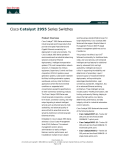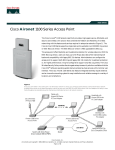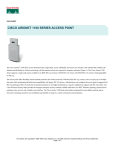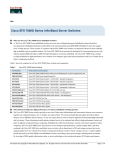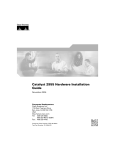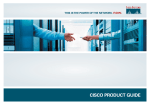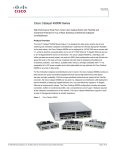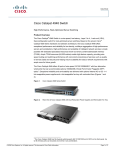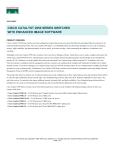Download Cisco WS-C2955C-12 - Syst. 2955 Switch Specifications
Transcript
Q&A Cisco Catalyst 2955 Series Product Overview Q. What is the Cisco Catalyst® 2955 Series? • Cisco Catalyst 2955T-12: Twelve 10/100 TX ports + two 10/100/1000 TX uplinks A. The Cisco Catalyst 2955 Series is a Q. How is the Cisco Catalyst 2955 Series product line of industrial Fast Ethernet and different from other Cisco Catalyst Gigabit Ethernet switches that are designed offerings? for harsh environment applications, including A. Based on the Cisco Catalyst 2950 Series factory automation networks (Industrial switch architecture, the Cisco Catalyst Ethernet), intelligent transportation 2955 Series delivers intelligent services, systems (ITS), and SCADA (Supervisory, such as high-availability, QoS, and security, Control and Data Acquisition) systems to harsh environments. for utility companies, military systems Key Cisco Catalyst 2955 Series hardware integrators, and other facilities or features are as follows: applications where the environmental conditions or suspended solid concentrations exceed the specifications of other commercial switching products. The Cisco Catalyst 2955 Series delivers intelligent services, such as high availability, quality of service (QoS), and security to a multitude of new Ethernet deployments • Dimensions (HxDxW): 3.75x5x8 in. • Mounting: DIN rail and 19 in. rack (with extenders) • Power: 24V (DC power converter is available) • Dual power feeds for redundant power cabling outside the traditional enterprise and • Operating temperature:–40ºC to 60ºC telecommunications markets. The Cisco • Use of extended temperature industrial Catalyst 2955 Series is compliant with standard industrial environmental ratings and specifications. Q. What are the configurations of the Cisco Catalyst 2955 Series? components • Passive convection cooling (no fans) • Relative humidity: 10 to 95% (noncondensing) • Shock and vibration: 50 g trapezoidal A. The Cisco Catalyst 2955 Series is shock/up to 500 Hz using available in three configurations: MIL-STD-810 • Cisco Catalyst 2955C-12: Twelve • Two alarm relays 10/100 TX ports + two 100 Mbps • Temperature sensor multimode fiber uplinks • Environmental Management • Cisco Catalyst 2955S-12: Twelve 10/100 TX ports + two 100 Mbps Information Base (MIB) • 32 MB RAM single-mode fiber uplinks Cisco Systems, Inc. All contents are Copyright © 1992–2003 Cisco Systems, Inc. All rights reserved. Important Notices and Privacy Statement. Page 1 of 11 Q. How is the Cisco Catalyst 2955 similar to other Cisco Catalyst offerings in terms of the software feature set? A. In addition to supporting all the enhanced image features of the Cisco Catalyst 2950, the Cisco Catalyst 2955 provides software support for additional hardware (relays, dual power intake) configuration, FCS error monitoring, and MIB support. Q. Why is the Cisco Catalyst 2955 powered with 24V DC? Do I have options? A. Most I/O devices run on 24V, making it commonly available on the factory floor. Cisco provides an optional DIN rail-mountable power converter allowing for 110/220V AC to be used (PWR-2955-AC). Q. How mechanically robust is the platform? A. The Cisco Catalyst 2955 meets extreme mechanical conditions, including accelerations of up to 50 g on each of its axes (trapezoidal) and multiple vibration levels up to 500 Hz using military testing specifications. Q. How are relays used? Why are they important? A. The Cisco Catalyst 2955 has two normally open relays that can be associated to different alarm conditions. Because many industrial control networks are used in motion control processes, there are important safety issues if a network fails. The relays allow for external alarm systems (generally a light or audible alarm) to be triggered if a given threshold error condition is reached. The relays can also be associated to other control devices such as a programmable logic controller (PLC) to launch a “controlled shutdown” for a given alarm condition. A controlled shutdown allows for a specific sequence of events to be initiated that will not damage or jeopardize the safety of the equipment or personnel running a given operation. Only Cisco offers a dual relay system that gives granularity to the alarm output. This allows the user to program a first initial alarm (yellow light) when a noncritical condition that needs attention is met, and a second alarm (red light) when the severity of the alarm merits immediate attention. In many scenarios, the equipment will be deployed by factory floor technicians (electricians) that are not initially familiar with networking monitoring systems or protocols. The relays allow for a simple and easy-to-use network alarm system. Q. Will the Cisco Catalyst 2955 Series operate standalone in harsh environments? A. The Cisco Catalyst 2955 Series physical protection is rated to IP20, the same rating that most factory floor production equipment have today. In most applications, production equipment (including the Cisco Catalyst 2955 Series) is housed in a NEMA-12 or IP55 enclosure. It is recommended that the Cisco Catalyst 2955 Series be used in an enclosure with the appropriate rating. Q. Do Cisco Catalyst 2950 Series switches support Gigabit Ethernet connectivity? Do they support Gigabit Interface Converter (GBIC)-based uplinks? A. Cisco Catalyst 2955 Series switches support Gigabit Ethernet connectivity on the WS-C2955T-12 model via fixed 10/100/1000BASE-T uplink ports. The switches do not currently support GBIC or small form-factor plugables (SFPs) based uplinks. Q. What kind of network management is available on the Cisco Catalyst 2955 Series switches? A. In addition to Cisco Cluster Management Suite (CMS) Software, Cisco Catalyst 2955 Series switches provide extensive management tools using Simple Network Management Protocol (SNMP) network management platforms such as CiscoWorks. Cisco Systems, Inc. All contents are Copyright © 1992–2003 Cisco Systems, Inc. All rights reserved. Important Notices and Privacy Statement. Page 2 of 11 Cisco Catalyst 2955 Series switches deliver a comprehensive set of management tools to provide the required visibility and control in the network. Managed with CiscoWorks, Cisco Catalyst switches can be configured and managed to deliver end-to-end device, VLAN, traffic, and policy management. Coupled with CiscoWorks2000, Cisco Resource Manager Essentials, a Web-based management tool, offers automated inventory collection, software deployment, easy tracking of network changes, views into device availability, and quick isolation of error conditions. Supported CiscoWorks applications include: • Campus Manager • CiscoView • Resource Manager Essentials • Device Fault Manager Q. What software features are available on Cisco Catalyst 2955 Series switches? A. The Cisco Catalyst 2955 Series software feature set delivers intelligent services, including advanced QoS with an ability to map differentiated services code point (DSCP) to class of service (CoS) or vice versa; rate limiting based on a wide range of access control parameters (ACPs) such as source/destination IP address, source/destination Media Access Control (MAC) and TCP/User Datagram Protocol (UDP) port number; and sophisticated security through filtering. In addition to Layers 3 and 4 lookups, the Cisco Catalyst 2955 Series offers ease of use and deployment features such Dynamic Trunking Protocol (DTP), Port Aggregation Protocol (PAgP), dynamic virtual LANs (VLANs), and VLAN Trunking Protocol (VTP) pruning. For a full range of software features supported by the Cisco Catalyst 2955 Series, refer to the Cisco Catalyst 2955 Series data sheet at http://www.cisco.com/go/catalyst2950. The Cisco Catalyst 2955 delivers superior LAN-edge Layer 2 QoS (unmatched in its class of products in the industry) and superior multicast management via Internet Group Management Protocol (IGMP) snooping in hardware. It also delivers wire-speed performance and all traditional wiring closet features, including a Web management interface, Network Timing Protocol (NTP), port-based VLANs, Fast EtherChannel® and Gigabit EtherChannel technologies, 802.1Q VLAN tagging support, VTP, UplinkFast, Per VLAN Spanning Tree Plus (PVST+), Terminal Access Controller Access Control System (TACACS+), and RADIUS . Q. What are the highlights of the security features available on Cisco Catalyst 2955 Series switches? A. The Cisco Catalyst 2955 offers enhanced data security through numerous security features. These features allow customers to secure network management traffic by encrypting passwords and configuration information; provide options for network security based on users, ports, or MAC addresses; and restrict access to sensitive areas of the network. Port-based ACPs restrict sensitive portions of the network by denying packets based on source and destination MAC addresses, IP addresses, or TCP/UDP ports. ACP lookups are done in hardware; therefore, forwarding performance is not compromised when implementing this type of security in the network. Port security provides another means to ensure that appropriate users are on the network, by limiting access based on MAC addresses. For authentication of users with a RADIUS server, 802.1x provides port-level security. 802.1x extensions include 802.1x with port security on a per-port basis, 802.1x with voice VLAN, and 802.1x with VLAN assignment. Cisco Systems, Inc. All contents are Copyright © 1992–2003 Cisco Systems, Inc. All rights reserved. Important Notices and Privacy Statement. Page 3 of 11 Secure Shell (SSH) Protocol and SNMPv3 protect information from tampering or eavesdropping by encrypting information being passed along the network, thereby guarding administrative information. These features are available only on the enhanced image. With the Cisco Catalyst 2955, network managers can implement high levels of console security. Multilevel access security on the switch console and the Web-based management interface prevent unauthorized users from accessing or altering switch configuration. TACACS+ and RADIUS authentication enable centralized access control of the switch and restrict unauthorized users from altering the configuration. Deploying security can be done through Cisco Cluster Management Suite (CMS) Software Security Wizards, which ease the deployment of security features that restrict user access to a server, a portion of the network, or the entire network. Q. Do Cisco Catalyst 2955 switches support switch clustering? A. Yes. Cisco Catalyst 2955 switches can be managed using Cisco CMS Software, which uses Cisco switch clustering technology. Cisco CMS is Web-based software that is embedded in Cisco Catalyst 3550, 2955, 2950, 2950ST-LRE, 3500 XL, 2900 XL, 2900 LRE XL, and 1900 switches. Through Cisco switch clustering technology, users can access Cisco CMS with any standard Web browser to manage up to 16 of these switches at once, regardless of their physical proximity—with the option of using a single IP address if desired. Cisco CMS provides an integrated management interface for Cisco Catalyst 2955 switches to deliver intelligent services such as multilayer switching, QoS, multicast, and security access control lists (ACLs). Cisco CMS allows administrators to take advantage of benefits formerly reserved for only the most advanced networks—without having to learn the command-line interface (CLI) or even the details of the technology. The new Cisco CMS Guide Mode leads the user step-by-step through the configuration of high-end features and provides enhanced online help for context-sensitive assistance. In addition, wizards provide automated switch configuration to optimally support video streaming or videoconferencing, voice over IP (VoIP), and mission-critical applications. Wizards for LAN security and multicast are also provided. Cisco CMS supports standards-based connectivity options such as Ethernet, Fast Ethernet, Fast EtherChannel, Gigabit Ethernet, and Gigabit EtherChannel connectivity. Because Cisco switch clustering technology is not limited to a single stack of switches, Cisco CMS expands the traditional cluster domain beyond a single wiring closet, saving time and effort for network administrators. Cisco Catalyst 2955 Series switches can be configured either as command or member switches in a Cisco switch cluster. Cisco CMS also allows the network administrator to designate a standby or redundant command switch, which takes the commander duties if the primary command switch fails. Other key features include the ability to simultaneously configure multiple ports and switches, perform software updates across the entire cluster at once, and clone configurations to other clustered switches for rapid network deployments. Bandwidth graphs and link reports provide useful diagnostic information, and the topology map gives network administrators a quick view of the network status. Q. Does the Cisco Catalyst 2955 Series support Inter-Switch Link (ISL) trunking? A. No. The Cisco Catalyst 2955 Series hardware does not support ISL trunking. For customers with a requirement to deploy ISL trunking, Cisco Catalyst 3550 switches support both ISL and 802.1Q trunks. Cisco Systems, Inc. All contents are Copyright © 1992–2003 Cisco Systems, Inc. All rights reserved. Important Notices and Privacy Statement. Page 4 of 11 Product Positioning Q. Why is Cisco delivering the Cisco Catalyst 2955 Series? A. The migration to Ethernet that began in the enterprise space ten years ago and has moved into the metro, wireless, and service provider markets is now extending to other networks (manufacturing control networks, for example). As Ethernet becomes ubiquitous and far more competitive than any other Layer 2 technology, new markets outside the traditional enterprise wiring closet are converging on Ethernet. New markets require hardware implementations that address the new and different environmental conditions that differ from “traditional” applications. The Cisco Catalyst 2955 allows Cisco to provide an end-to-end solution in many new markets where a new set of competitors is beginning to position themselves on the premise that Cisco does not have a hardened solution that meets the new markets’ environmental, power, and form-factor requirements. The traditional Layer 2 networks that are being replaced with Ethernet solutions have been highly reliable and secure, but significantly limited in terms of bandwidth, interconnectivity, and standardization. By deploying intelligent Ethernet solutions, Cisco can deliver the benefits of an Ethernet architecture with the reliability and security that are a hard requirement in these new markets. Q. Why is the Cisco Catalyst 2955 the best solution? A. From a technology perspective, Cisco is the only solution in the market that provides intelligent services in a hardened platform. Most of the networks that are being replaced with Ethernet carry critical information that cannot tolerate latency, downtime, or intrusion from unauthorized users. Multiple features of the Cisco Catalyst architecture, including support for rapid spanning tree, IGMP snooping, storm control, and MAC address notification are critical to establishing a deterministic, secure, and highly available network. These features are only provided by the Cisco Catalyst product family. From a solution’s perspective, only Cisco can provide an end-to-end solution with a common management platform, consistent QoS policies, and a scalable architecture. Q. Are all ITS networks compatible with the Cisco Catalyst 2955 Series? A. ITS architectures are rapidly moving to a TCP/IP infrastructure. Currently, ITS networks use several architectures, including Synchronous Optical Network (SONET), Asynchronous Transfer Mode (ATM), serial, coax, Ethernet, and wireless. The NTCIP standard has recommended TCP/IP for data structures (for more information, see http://www.NTCIP.org). To be NCTIP-compliant, future traffic control equipment must support an IP interface. Terminal servers are used to convert legacy serial connections to Ethernet. Departments of transportation use the NEMA-TS2 compliance specification, which the Cisco Catalyst 2955 meets for traffic control hardware recommendations. Q. Why does the Cisco Catalyst 2955 not offer a lifetime warranty like some other Cisco Catalyst products? A. Given that the environments where the Cisco Catalyst 2955 can be deployed are significantly more demanding and uncontrolled and no active cooling is feasible, the product has a five-year limited warranty. This exceeds the traditional warranties from the equipment traditionally deployed in the factory floor and those of any significant competitor. Cisco Systems, Inc. All contents are Copyright © 1992–2003 Cisco Systems, Inc. All rights reserved. Important Notices and Privacy Statement. Page 5 of 11 Q. Ethernet is being deployed in new environments and for new solutions that traditionally have required very low bandwidth. Why do they need intelligent services? A. Different issues are driving the move to Ethernet in multiple new markets. In general, the level of information traversing networks is increasing as the hosts on these networks increase their functionality and users look for ways of retrieving real-time data from the processes they are controlling and monitoring. Traditional proprietary networks (fieldbuses) do not have the bandwidth to handle these new informational requirements, but they have traditionally been very reliable and deterministic (based on token-sharing topologies). This has allowed for critical control traffic to be delivered on time, but not much more. As Ethernet-based solutions are deployed, critical traffic will be sharing the network bandwidth with non-critical (data collection and configuration) traffic, creating the possibility that delay-sensitive information is affected as the data traffic in the network grows. This will be aggravated by the addition of traditional applications (voice, video, and e-mail) to a common Ethernet infrastructure, similar to the convergence of voice and data networks now prevalent in the traditional LAN markets. By providing traffic prioritization based on the parameters of Layers 2–4, a network administrator can guaranty that delay-sensitive and critical-control traffic always has precedence over non-critical traffic. Another element driving the deployment of Ethernet networks is the recognition that internetworking technologies that allow for data sharing through various networks (internal and external) can be a competitive advantage for an organization. With their industry-specific networking schemes, traditional field buses were essentially closed networks and did not facilitate data exchange or intrusion into the networks. Industrial Ethernet deployments are based not only on Ethernet, but also on IP addressing schemes that allow for new levels of communication and information exchanges. This in turn requires a new set of policies and security services, which the Cisco Catalyst 2955 offers. In a manufacturing operation, the automation process is the revenue engine of the organization. Network downtime is easily equated to losses. It is critical that the network is highly available. Intelligent services such as fast spanning tree, storm control, and multicast management are part of the services that provide the level of resilience demanded by nontraditional Ethernet deployments. Q. Why is IGMP snooping important in manufacturing networks? A. New markets and applications may involve data flows that differ from traditional LAN deployments. Most industrial Ethernet implementations rely on a producer-consumer model, where a host that needs to send data (producer) to another device in the network (consumer) multicasts the information instead of sending a unicast message to the device. This model was developed to ensure that if two or more devices (consumers) needed a set of data, that all the devices requesting that data would have access to the same information at the same time. IGMP snooping prunes the multicast traffic so that only the devices that need the information from a given consumer will receive it. Without multicast management services, the traffic in the network grows exponentially with the number of hosts that become producers. This not only overburdens the network, but may also stall the hosts receiving unneeded traffic. Many I/O devices common in industrial networks have limited processing power and will not be able to process multiple streams of unneeded data—potentially choking these devices. Cisco Systems, Inc. All contents are Copyright © 1992–2003 Cisco Systems, Inc. All rights reserved. Important Notices and Privacy Statement. Page 6 of 11 Cisco Catalyst 2955 Series Roadmap Q. Does the Cisco Catalyst 2955 support IP routing? A. No. For Layer 3 routing functionality, the Cisco Catalyst 3550 is an alternative stackable platform in combination with adequate packaging (third party) to withstand environmental conditions outside its specifications. Service and Warranty Q. What is the warranty for Cisco Catalyst 2955 Series switches? A. Cisco Catalyst 2955 Series switches come with the Cisco Limited 5-Year Hardware and 1-Year Software Warranty (http://www.cisco.com/univercd/cc/td/doc/es_inpck/511ben__.htm). Q. What types of service and support are available for Cisco Catalyst 2955 Series switches? A. A full complement of life-cycle service and support is available for the Cisco Catalyst 2955 Series. From implementation to operation and optimization, Cisco offers technical support service and advanced service, delivered either directly by Cisco or through one of its best-in-class partners. Technical Support Service Technical Support Service is available through Cisco SMARTnet™ and SMARTnet Onsite. SMARTnet support augments the resources of your customer’s operations staff by providing them with access to a wealth of expertise, both online and via telephone, and a range of hardware advance replacement options. SMARTnet Onsite complements the hardware advance replacement feature by adding the services of a field engineer—services that can be critical for those locations where staffing is insufficient or unavailable to perform parts replacement activities. For more information on SMARTnet support, visit: http://www.cisco.com/en/US/products/svcs/ps3034/ps2827/ps2978/serv_home.html Advanced Service Cisco Total Implementation Solutions (TIS) offers a full range of implementation solutions, including project management, project engineering, configuration, staging, and rollout coordination, ensuring correct installation and deployment. Configuration services now include development and verification of configuration for intelligent services such as QoS and multicast. For more information on Cisco TIS, visit: http://www.cisco.com/en/US/products/svcs/ps11/ps2902/ps3061/serv_home.html For more information on configuration services for QoS and multicast, contact [email protected]. Product and Contact Information Q. Where can I find technical and product specifications and other additional information on Cisco Catalyst 2955 switches? A. For product literature such as data sheets and product specifications, visit the Cisco Catalyst 2955 Web site at: http://www.cisco.com/go/catalyst2950 Cisco Systems, Inc. All contents are Copyright © 1992–2003 Cisco Systems, Inc. All rights reserved. Important Notices and Privacy Statement. Page 7 of 11 Q. What are the part numbers for Cisco Catalyst 2955 switches? When do they become orderable? A. The part number and order information for Cisco Catalyst 2955 switches can be found at: http://www.cisco.com/go/catalyst2950 Cisco Catalyst 2955 Technical Q&A Q. If I want to provide redundant power to my Cisco Catalyst 2955 switches, how would I implement this solution? A. Connect two independent 24V power sources to the Cisco Catalyst 2955 and configure the switch for dual-power intake. Each supply is monitored, and alarms can be generated if one source fails. Q. How can I connect the 100BASE-FX ports of the Cisco Catalyst 2955C-24 to a 100BASE-FX ports device that has an SC or ST connector? A. Fiber patch cables are available from Cisco in one-, three-, or five-meter lengths for connecting the MT-RJ connector on your Cisco Catalyst 2955C-24 to another 100BASE-FX device with an SC or ST connector. Table 1 lists the part numbers. Table 1 Cisco Fiber Patch Cable Description Part Number Availability 1-meter MT-RJ to SC Patch Cable CAB-MTRJ-SC-MM-1M Now 3-meter MT-RJ to SC Patch Cable CAB-MTRG-SC-MM-3M Now 5-meter MT-RJ to SC Patch Cable CAB-MTRJ-SC-MM-5M Now 1-meter MT-RJ to ST Patch Cable CAB-MTRJ-ST-MM-1M Now 3-meter MT-RJ to ST Patch Cable CAB-MTRJ-ST-MM-3M Now 5-meter MT-RJ to ST Patch Cable CAB-MTRJ-ST-MM-5M Now Q. What features are enabled and disabled by default on the Cisco Catalyst 2955? A. Table 2 shows the features enabled and disabled by default on the Cisco Catalyst 2955. Table 2 Features Enabled and Disabled by Default Enabled Disabled Dynamic Host Configuration Protocol (DHCP) Client Storm control Cisco Discovery Protocol and Address Resolution Protocol (ARP) Console, buffer, and file logging Dynamic Address Management Remote Monitoring (RMON) IGMP Snooping Address security Clustering Hot Standby Router Protocol (HSRP) Port security, TACACS+, and protected port Spanning-Tree Protocol Switched Port Analyzer (SPAN) port monitoring Cisco Systems, Inc. All contents are Copyright © 1992–2003 Cisco Systems, Inc. All rights reserved. Important Notices and Privacy Statement. Page 8 of 11 Other default feature details for the Cisco Catalyst 2955 Switch include: • Management VLAN is VLAN1 • VLAN Membership-Static access ports are in VLAN1 • VTP Management-VTP server mode • Autonegotiation of port speed and duplex settings Q. How does IGMP snooping operate in Cisco Catalyst 2955 switches? A. IGMP snooping in the Cisco Catalyst 2955 resolves the typical undesirable behavior of a Layer 2 switch that floods multicast packets to all ports in the ingress VLAN. Instead, the Cisco Catalyst 2955 snoops for incoming IGMP requests and decides where the IP multicast members reside. Based on the multicast group membership information from the IGMP packet, the Cisco Catalyst 2955 sets up a forwarding table for that specific multicast group’s traffic. This setup allows the Cisco Catalyst 2955 to forward the IP multicast traffic of a specific group to only the ports that have active members of the group. Q. What is multicast VLAN registration (MVR) and how does it relate to an IP multicast implementation? A. In multi-VLAN networks, subscribers to a multicast group may exist in more than one VLAN. Because of the VLAN boundary restrictions in a network that consists of Layer 2 switches, it may be necessary to replicate the multicast data transmission to the same group in different VLANs, even if they are on the same physical network. This results in more bandwidth being consumed than is required for a single data stream to a group. MVR alleviates this problem by registering a common VLAN for the source and receivers of the multicast data. MVR defines two types of ports—source ports and receiver ports. Source ports are ports where the multicast data source is connected, and receiver ports are ports where subscribers are connected. MVR treats both of these types of ports as if they belong to the same VLAN for switching multicast stream for configured multicast address. Q. Is IGMPv3 supported on the Cisco Catalyst 2955? A. Yes. Q. What is 802.1x and how can I implement it in my network? A. 802.1x is an IEEE standard that defines how devices should be authenticated when they are attached to LAN ports. In order to implement 802.1x, a RADIUS authentication server such as Cisco ACS Version 3.0 is needed. Q. I have the existing Cisco Catalyst 2900 XL and 3500 XL switches that support Cisco Group Management Protocol. Will these devices interoperate with Cisco Catalyst 2955 switches, which support IGMP snooping? A. Yes. The Cisco Catalyst 2955, which supports IGMP snooping, will fully interoperate with your existing Cisco Catalyst 2900 XL and 3500 XL products that support Cisco Group Management Protocol. Q. What is the maximum number of multicast entries or groups allowed per Cisco Catalyst 2955 Switch? A. The Cisco Catalyst 2955 switches support a maximum of 255 IP multicast groups and support both IGMPv1 and IGMPv2. Q. What does the mrouter option under IGMP snooping do? A. Multicast-capable router ports are added to the forwarding table for every IP multicast entry. The switch learns of such ports through one of these methods: Cisco Systems, Inc. All contents are Copyright © 1992–2003 Cisco Systems, Inc. All rights reserved. Important Notices and Privacy Statement. Page 9 of 11 • Snooping on Protocol-Independent-Multicast (PIM) and Distance-Vector-Multicast-Routing-Protocol (DVMRP) packets • Listening to Cisco Group Management Protocol self-join packets from other routers • Statically connecting to a multicast router port with the ip igmp snooping mrouter command You can configure the switch to either snoop on PIM/DVMRP packets or to listen to Cisco Group Management Protocol self-join packets. By default, the switch snoops on PIM/DVMRP packets on all VLANs. To learn of multicast router ports through only Cisco Group Management Protocol self-join packets, use the ip igmp snooping vlan vlan_id mrouter learn cgmp global configuration command. When this command is used, the router listens only to Cisco Group Management Protocol self-join packets and no other Cisco Group Management Protocol packets. To learn of multicast router ports through only PIM/DVMRP packets, use the ip igmp snooping vlan vlan_id mrouter learn pim-dvmrp interface command. Q. How granular can the rate limiting policing be set? A. The granularity of policers is 1 Mbps on Fast Ethernet ports and 8 Mbps on Gigabit Ethernet ports. The Cisco Catalyst 2955 supports 6 policers on 10/100 ports and up to 60 policers on Gigabit Ethernet ports. Please note that this feature is available on the Cisco Catalyst 2955T, 2955C, and 2955S switches. Q. Is rate limiting supported? Is traffic shaping supported? A. Rate limiting is supported. Traffic shaping is not supported. Q. What are the default CoS values on the Cisco Catalyst 2955? A. The default CoS values are shown in Table 3. Table 3 Default CoS Values CoS Value CoS Priority Queue 0,1 1 2,3 2 4,5 3 6,7 4 Q. What are the configurable ranges for Weighted Round Robin (WRR) bandwidth allocation to all queues of transmission? A. WRR scheduling can be enabled to avoid starvation of frames in lower-priority queues by providing configurable bandwidth allocation, using a number of 1-255 per queue. Q. Can IGMP snooping and QoS on the Cisco Catalyst 2955 be configured via Cisco CMS Software? A. Yes. Cisco IOS Software Release 12.0(5)WC1 supports configuration of both IGMP snooping and QoS via Cisco CMS, using simple point-and-click menus for enabling and disabling the features, as well as configuring parameters. Q. Does the Cisco Catalyst 2955 support the 802.3ad Port Grouping standard? A. Yes. Cisco Systems, Inc. All contents are Copyright © 1992–2003 Cisco Systems, Inc. All rights reserved. Important Notices and Privacy Statement. Page 10 of 11 Q. How will the Cisco Catalyst 2955 handle IPv6 packets? Q. Does the Cisco Catalyst 2955 implement 802.3x flow control on A. These switches will be able to bridge IPv6 packets. However, the 10/100 and 10/100/1000 ports? QoS or ACLs cannot be enabled for the IPv6 packets except for A. Flow control is supported on the 1000BASE-T ports only when Layer 2 based ACP. the operating speed is 1000 Mbps and the mode is full duplex. Q. What types of processing occur via the CPU instead of the Q. Are the Flash and packet buffer upgradable on the Cisco switching subsystem? Catalyst 2955? A. Processing via the CPU includes address learning and A. No. Neither the Flash nor the packet buffer is upgradable on the management (Telnet, Web, etc.). The CPU also manages Cisco Catalyst 2955. VLAN tables. Corporate Headquarters Cisco Systems, Inc. 170 West Tasman Drive San Jose, CA 95134-1706 USA www.cisco.com Tel: 408 526-4000 800 553-NETS (6387) Fax: 408 526-4100 European Headquarters Cisco Systems International BV Haarlerbergpark Haarlerbergweg 13-19 1101 CH Amsterdam The Netherlands www-europe.cisco.com Tel: 31 0 20 357 1000 Fax: 31 0 20 357 1100 Americas Headquarters Cisco Systems, Inc. 170 West Tasman Drive San Jose, CA 95134-1706 USA www.cisco.com Tel: 408 526-7660 Fax: 408 527-0883 Asia Pacific Headquarters Cisco Systems, Inc. Capital Tower 168 Robinson Road #22-01 to #29-01 Singapore 068912 www.cisco.com Tel: +65 6317 7777 Fax: +65 6317 7799 Cisco Systems has more than 200 offices in the following countries and regions. Addresses, phone numbers, and fax numbers are listed on the Cisco Web site at www.cisco.com/go/offices Argentina • Australia • Austria • Belgium • Brazil • Bulgaria • Canada • Chile • China PRC • Colombia • Costa Rica • Croatia Czech Republic • Denmark • Dubai, UAE • Finland • France • Germany • Greece • Hong Kong SAR • Hungary • India • Indonesia • Ireland Israel • Italy • Japan • Korea • Luxembourg • Malaysia • Mexico • The Netherlands • New Zealand • Norway • Peru • Philippines • Poland Portugal • Puerto Rico • Romania • Russia • Saudi Arabia • Scotland • Singapore • Slovakia • Slovenia • South Africa • Spain • Sweden S w i t z e r l a n d • Ta i w a n • T h a i l a n d • Tu r k e y • U k r a i n e • U n i t e d K i n g d o m • U n i t e d S t a t e s • Ve n e z u e l a • Vi e t n a m • Z i m b a b w e All contents are Copyright © 1992–2003 Cisco Systems, Inc. All rights reserved. CCIP, CCSP, the Cisco Arrow logo, the Cisco Powered Network mark, the Cisco Systems Verified logo, Cisco Unity, Follow Me Browsing, FormShare, iQ Breakthrough, iQ FastTrack, the iQ logo, iQ Net Readiness Scorecard, Networking Academy, ScriptShare, SMARTnet, TransPath, and Voice LAN are trademarks of Cisco Systems, Inc.; Changing the Way We Work, Live, Play, and Learn, The Fastest Way to Increase Your Internet Quotient, and iQuick Study are service marks of Cisco Systems, Inc.; and Aironet, ASIST, BPX, Catalyst, CCDA, CCDP, CCIE, CCNA, CCNP, Cisco, the Cisco Certified Internetwork Expert logo, Cisco IOS, the Cisco IOS logo, Cisco Press, Cisco Systems, Cisco Systems Capital, the Cisco Systems logo, Empowering the Internet Generation, Enterprise/Solver, EtherChannel, EtherSwitch, Fast Step, GigaStack, Internet Quotient, IOS, IP/TV, iQ Expertise, LightStream, MGX, MICA, the Networkers logo, Network Registrar, Packet, PIX, Post-Routing, Pre-Routing, RateMUX, Registrar, SlideCast, StrataView Plus, Stratm, SwitchProbe, TeleRouter, and VCO are registered trademarks of Cisco Systems, Inc. and/or its affiliates in the U.S. and certain other countries. All other trademarks mentioned in this document or Web site are the property of their respective owners. The use of the word partner does not imply a partnership relationship between Cisco and any other company. (0301R) WH/LW4206 02/03











